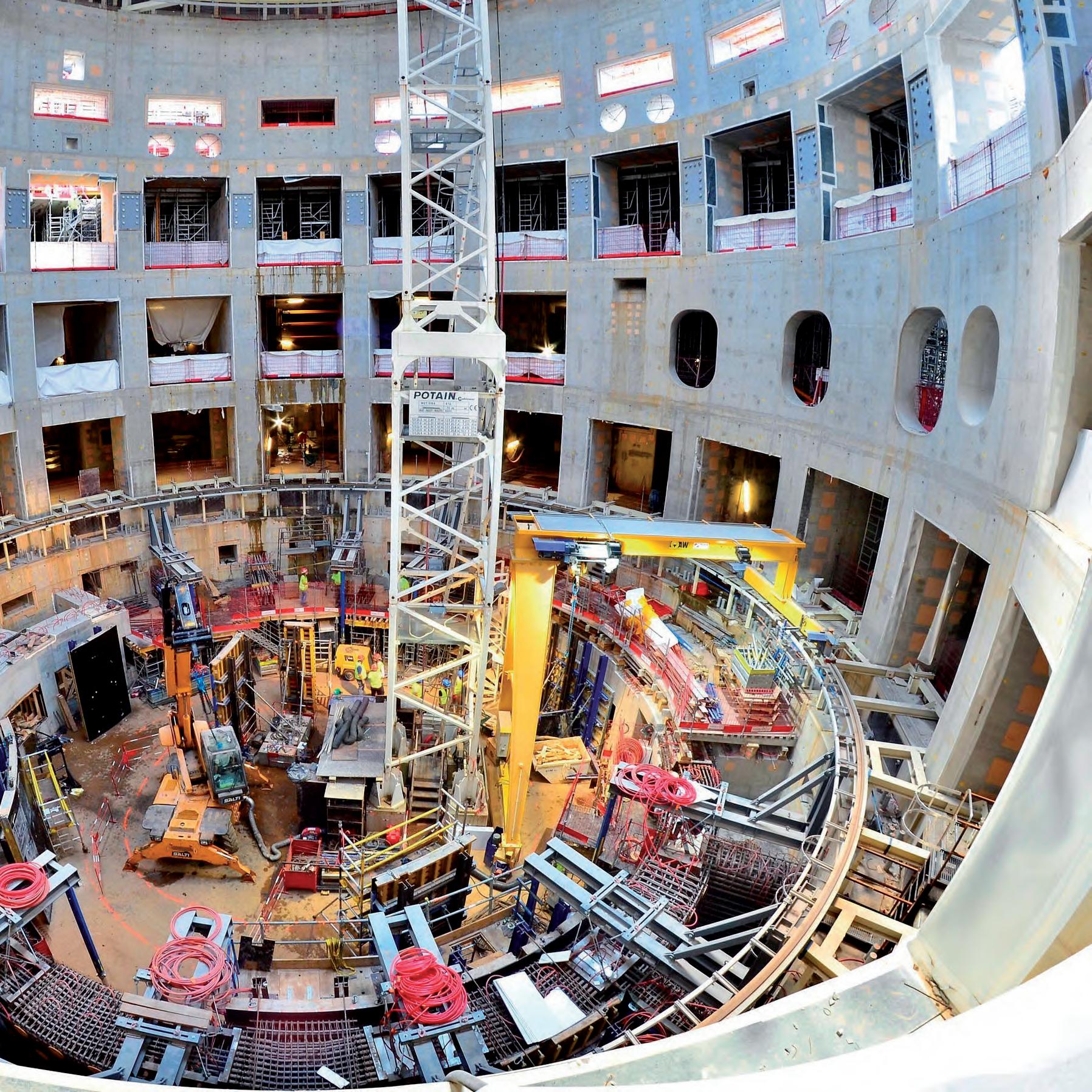
14 minute read
Fernando Rueda Didier Combescure
SUPPORTING THE 23,000-TONNE ITER REACTOR AND ITS SYSTEMS
Fernando Rueda (ESTEYCO Mechanics) Didier Combescure (Fusion for Energy)
Advertisement
INTRODUCTION
Supporting the huge and totally unique Tokamak machine is a challenge, due to the highly demanding environment, the limited space available, the complexity and magnitude of the loads involved –both during normal operational and under accident conditions–, the safety requirements arising from ITER being a nuclear facility, and, last but not least, the management and contractual obstacles associated to this multi-national and multi-disciplinary endeavour. A global overview of the main principles behind the design of this very singular supporting structure within the ITER reactor building, including the very complex loading induced by the Tokamak machine is provided next. The text is largely based on the paper Supporting the giant 23,000 tonne ITER Tokamak nuclear fusion reactor we wrote and presented at the International fib Symposium on Conceptual Design of Structures that took place in Switzerland between the 16 and 18 September 2021. Some historical background about major design evolutions that significantly affected the original structural concept is also given, focusing on the increasing relevance that reinforced concrete took during the design process in order to address many of the challenges this once purely mechanically-oriented engineering task had to face over the years. Further, but in the end, crucial complications that arose from scheduling and contractual aspects are also mentioned.
The design of both the Tokamak machine and its supporting scheme is determined by some operational and accidental regimes that the system must be able to cope with. These constraints mainly come from the following sources: (1) thermal conditions corresponding to different machine statuses, (2) gravity loads induced by the extremely large mass of the system, (3) seismic threats to be faced and, last but not least, (4) the high level of congestion in the very limited space (in proportion to the magnitude of the loads involved) available for the implementation of the supporting scheme.
1. The main Tokamak machine components operate in a variety of thermal conditions that are behind many of the design constraints that need be accounted for from the very beginning of the design process. Under normal ITER plasma operation conditions, the superconducting magnets are at 4K, whereas the vacuum vessel and the cryostat are at 100°C and room temperature (around 30°C), respectively. During some maintenance and conditioning operations, the vacuum vessel temperature increases to 200°C.
Some postulated accidents inside the cryostat (cryostat ingress of coolant events, Cr ICEs) foresee the rupture of pipes carrying cryogenic helium coolant for the feeding of the superconducting magnets, with the resulting leaks making the cryostat temperature drop to around –93°C (180K). This extremely quick summary reflects that maximum temperature ranges up to 500°C (not simultaneously) have to be accommodated by the Tokamak machine design. For such stiff and heavy components this has major implications. These thermal gradients also affect any conceptual approach for the design of the supporting structure.
2. The 23,000 tonnes of the Tokamak machine clearly limit the options available for the design of a feasible supporting scheme, especially when taking into account constraints imposed by the other factors. 3. As a nuclear facility, the seismic design of ITER must ensure the corresponding seismic safety requirements are met according to the nuclear regulation of the host state (France). The design earthquake for ITER (Safe Shutdown Earthquake, SSE) is generated as the envelope of two seismic events: the Seisme
Majore de Securité (SMS) and the paleoseism. The Zero Period Acceleration (ZPA) is equal to 0.315g. The vertical motion is derived by multiplying the horizontal motion by 2/3. 4. Despite the scale of the loads involved, the availability of space to devise a robust supporting scheme is very much reduced due, not only to the global size of the machine, but to the vast number of penetrations and services that must access the machine at various levels.
The first mechanical design choice at a Tokamak machine level is to completely decouple the superconducting magnets system and the vacuum vessel from a structural point of view. These two large and heavy parts only share one common supporting element: the pedestal ring (Figure 1, middle), which is an integral part of the cryostat. The pedestal ring is a very rigid stainless steel
circular beam with a rectangular hollow cross-section, and wall thicknesses of almost 200mm. A photograph of the pedestal ring from the inside is shown in Figure 2. The whole magnet system (Figure 1 left) is supported mechanically speaking by eighteen Toroidal Field Coils, which rest on the pedestal ring by means of the Gravity Supports (see Figure 3). Each of these supports induces a vertical load of around 5.7MN only due to the mass of the magnet system and is designed to be very flexible for radial motions, in order to accommodate the thermal contractions resulting from the large temperature variations, but stiff in the circumferential and vertical directions.
The vacuum vessel (Figure 1 right) has penetrations called ports to provide access to the plasma at three levels. The vacuum vessel rests on nine gravity supports, each transferring a vertical load around 9.7 MN to the pedestal ring due to selfweight. These supports are also designed not to constrain the radial expansion of the vacuum vessel when its temperature increases to 100°C or 200°C.
Fig. 1. Internal supporting scheme – Tokamak machine arrangement.
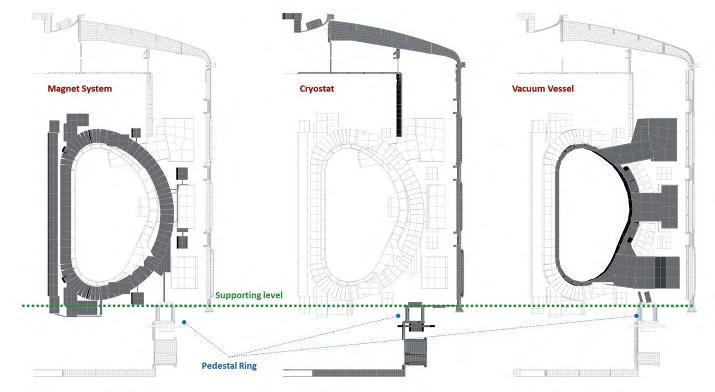
Fig. 2. Interior of the pedestal ring supporting the magnet system and vacuum vessel (©ITER Organization).

Fig. 3 Toroidal Field Coil Gravity Supports (©ITER Organization).

HISTORICAL BACKGROUND AND DESIGN RATIONALE
There is a key decision, inherited from the internal arrangement selected for the main machine components, which determines many other factors along the line through the design process: where to place the supports, both in the vertical (supporting function) and horizontal (seismically restraining function) directions. As already anticipated, only one supporting level (Figure 1) is adopted for vertical loads: the pedestal ring upper flange. This is a very sensible choice in view of the thermal gradients associated with normal operating conditions of the Tokamak machine. Providing supports at supplementary levels would make the transfer of gravity loads not statically determined and this would require a very complex means of making this supporting condition compatible with absorbing the thermal expansions/contractions involved. Note that both radial and vertical thermal deformations of the vacuum vessel when supported on the pedestal ring reach a number of centimetres for equatorial and upper ports under usual operating or maintenance conditions. For horizontal loads, the same (and only) supporting level as for vertical loads is used. Implementing no additional levels for the transfer of horizontal loads is also a natural choice in view of the thermal deformations expected, which are absorbed by means of (1) large bellows to accommodate differential thermal expansions between the vacuum vessel and the cryostat and (2) mechanical independence of the magnet system with respect to the rest of the Tokamak machine. This mechanical independence is actually compulsory from a thermal point of view since the magnets will operate at 4K. However, having the pedestal ring as the only interface to transfer horizontal loads has significant implications when seismic responses are considered. This design choice means that horizontal seismic loads and, in particular, induced rocking moments due to the vertical eccentricity between the Tokamak machine centre of gravity and the elevation of the supporting level, are to be transferred only through that interface. This would involve huge seismic loads
Fig. 4. The ITER Tokamak Complex. and an almost impossible-to-design support in practical engineering terms, unless seismic motions are filtered before reaching the Tokamak machine. That is at least partially, behind the high level ITER project decision to introduce a seismic isolation system for the whole reactor building, the Tokamak Complex (see Figure 4), which is seismically isolated from the seismic pit basemat by 493 anti-seismic bearings (ASBs) that support the bottom basemat of the entire building. The ASBs are 900 × 900mm2 pads mounted on top of short columns (‘plinths’) that rise out the seismic pit basemat (see Figure 5). A comparison between seismic floor response spectra at the support level of the Tokamak machine for the design earthquake of 10,000 years return period with and without seismic isolation would result in increment of seismic loads for non-isolated option by a factor of 4, a loading increment that would not be affordable for the project, since it was difficult enough already to design the support with the help of the Tokamak Complex base isolation. In addition to this, it must be recalled that the support of the Tokamak machine is only one-though a very relevant one-of the hundreds if not thousands of ITER systems affected by this seismic isolation.
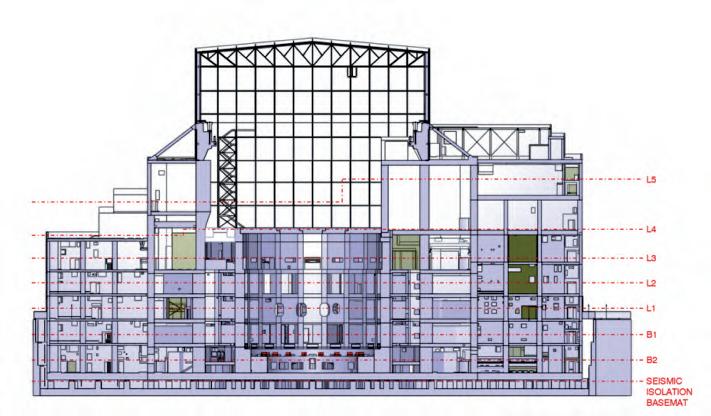
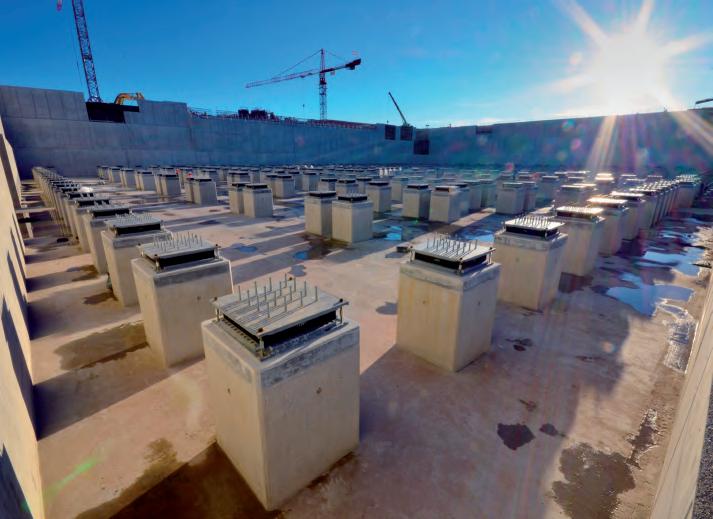
From a thermal point of view, differential expansions/contractions at the vacuum vessel and magnet system supports are addressed by a very specific design of such supports, since neither the vacuum vessel nor the magnet system have any other structural connection with the building. However, when it comes to the transfer of thermally imposed displacements to the building, the fact that during cryostat ingress of coolant events the temperature of the pedestal ring drops to around –100°C with respect to that of the building drives the design of the whole supporting structure. Figure 6 shows the conceptual design of the supporting scheme we first saw when started working on the design of this complex interface, more than a decade ago. The pre-conceptual design was based on eighteen steel columns (one below each Toroidal Field Coil Gravity Support) welded to the pedestal ring and assumed to
Fig. 5. Tokamak Complex seismic isolation during construction (©ITER Organization).
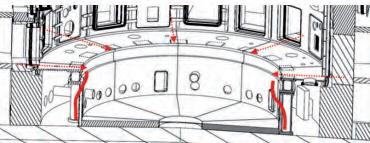
Fig. 6. Old Tokamak machine support concept (discarded in 2010).
Fig. 7. Complementary load transfer mechanisms for Tokamak machine support -VSS & TSS- (photographs ©ITER Organization). be anchored to the reinforced concrete basemat slab below. The red arrows show the direction of the pedestal ring contraction under Cr ICEs and the resulting deformed shape of the columns in red. Over-constraining imposed deformations of very stiff structural systems should always be avoided and this solution was discarded not long after this fault was identified. In addition to the main contribution from the vertical columns, two complementary load transfer mechanisms were foreseen as reflected in Figure 7: • Eighteen radial plates located at the lower periphery of the cryostat that prevent the relative motion of the machine with respect to the building in the toroidal (i.e. circumferential) direction while allowing for thermal expansions in the radial direction (Toroidal Skirt Support, TSS). • A continuous support at the periphery skirt of the lower cryostat preventing the vertical motion of the cryostat while allowing for relative motion between the base of the cryostat and the bio-shield wall in the horizontal plane (Vertical Skirt Support, VSS).
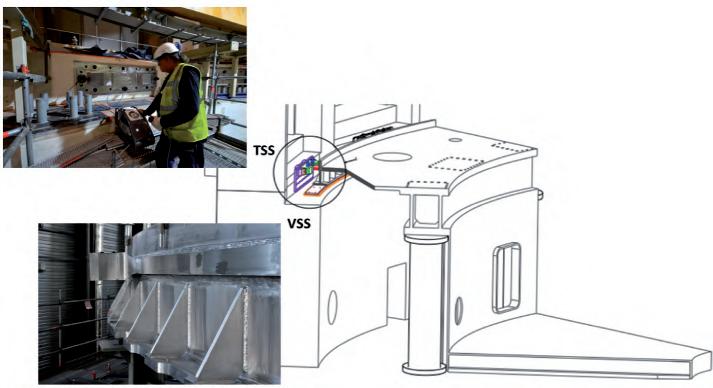
Radial-Poloidal cut through CSB center

IMPLEMENTATION OF THE TOKAMAK MACHINE SUPPORT
A complete re-design of the Tokamak machine supporting structure was then addressed in 2012, replacing the pre-conceptual solution based on eighteen stiff steel columns by a reinforced concrete structure, the so-called ‘reinforced concrete crown’ (RC crown), while keeping the two additional load transfer mechanisms described previously (VSS and TSS). This implied non-negligible changes in many of the most important ITER systems, which were tackled in a very efficient and coordinated manner by the project. This new supporting concept relies on two additional and key supporting elements that served as the interface between the Tokamak machine loads coming from the pedestal ring and the reinforced concrete structure, the so-called Cryostat Support Bearings (CSB) and Steel Transition Piece (STP).
Toriodal-Poloidal cut through CSB center
Fig. 8. Cryostat Support Bearings location (photographs ©ITER Organization).
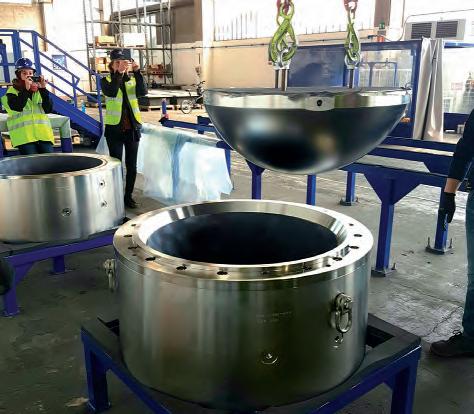
Fig. 9. Cryostat Support Bearings (photographs ©ITER Organization).
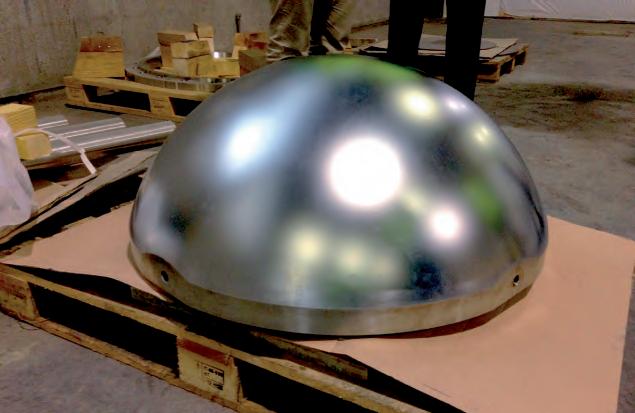
• Cryostat Support Bearings (CSB) – Eighteen CSBs, one at the vertical projection of each TFC gravity support, are responsible for transferring the complex loads from the pedestal ring to the RC crown while allowing for the required (radial) thermal contraction of the Tokamak machine with respect to its supporting structure (a contraction that can reach values in excess of 20mm during Cr ICEs). The CSBs, designed and manufactured by French company Nuvia, are low friction spherical bearings with a primary (flat, mainly for relative machine-building horizontal sliding) and a secondary (spherical, mainly for assembly) sliding interfaces. A sketch with the position of the
CSBs between the cryostat pedestal ring and the RC crown is shown in Figure 8, complemented with a picture of an actual CSB already put in place. More detailed views of the CSBs are provided in Figure 9. Extensive design and advanced FE analysis works were undertaken for the definition of these key elements, including an experimental campaign with both scaled and full-scale models, before the CSBs were manufactured and assembled on site.
• Steel Transition Piece (STP) - The vertical loads transferred by the CSBs are very high due to the large mass of the Tokamak machine. Typically, the

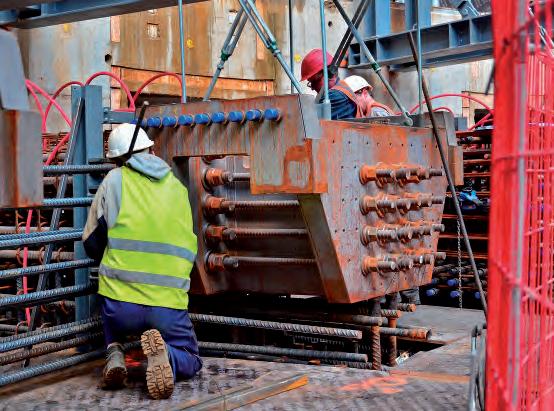
dead load of the equipment alone at each bearing point is around 1,100 tonnes, increasing to over 2,500 tonnes under certain extreme accidental conditions. The stresses under the bearing are therefore quite significant. In addition, there are also relatively high horizontal loads and moments applied, the size of which is limited by the frictional capacity of the primary and secondary sliding surfaces of the CSB. The highly concentrated loads from the CSBs could not be transferred directly to the RC crown, since this would exceed the local capacity of concrete to withstand such large compressive stress levels. The STP supports the CSB and transfers vertical and horizontal loads and moments into the RC crown, which in turn transfers this loading to the basemat below and the seismic isolation pads. Due to the large horizontal loads and moments applied to the STP by the CSB, large shear keys are required for transferring the horizontal loads. In addition, the final STP design had to be compatible with some key project decisions that were made before on the RC crown and implemented on site, such as the implementation of a very dense passive steel reinforcement arrangement to tie the STP in the radial direction, as opposed to the pre-stressed solution we originally proposed in 2012. The STP design therefore had to comply with a correct connection with the
Fig.10. STP on site: view of Top plate -left- and Embedded Frame -right- (©ITER Organization).
Fig. 11. Advanced non-linear finite element analyses for final design and structural substantiation of the Tokamak machine supporting structure.
dense pattern of radial (HB50) and circumferential (HB40) reinforcement bars of the RC crown already built by the time the STP design had to be completed. This, together with the highly demanding construction and assembly tolerances to be met, made it necessary to split the STP into two main components, the Embedded Frame (Figure 10 right) and the Top plate (Figure 10 left). Intensive integration work based on 3D CAD models retrofitted by on-site surveys was undertaken for the construction and execution designs. The final structural design and substantiation required advanced non-linear FE analyses (Figure 11) to account for the non-linear (i.e. contact) transfer of loads between steel and concrete parts, as well as for non-linear material properties, mainly under accidental load cases (concrete cracking and crushing and local steel yielding). A correct and suitable for reinforced concrete and structural steel design interpretation of the complex loading coming from the Tokamak machine was also a key aspect of the design activities. The design of the RC crown structure (Figure 12) is integrated with the bio-shield wall at its outer edge and with the bottom slab, directly supported by the ASBs. The main structural elements of the RC crown are the eighteen radial walls that support self-weight, vertical dynamic loads and a certain fraction of the horizontal dynamic acting on the Tokamak machine. As already
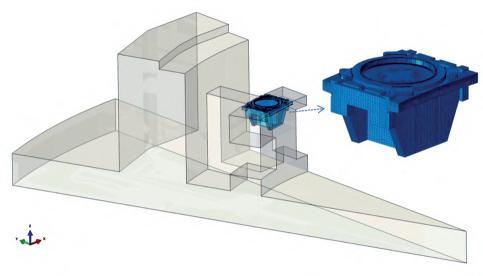
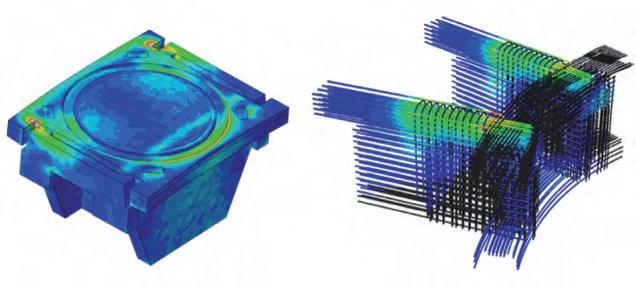
mentioned, a CSB is placed on top of each of these eighteen radial walls in order to provide the required interface with the pedestal ring. The radial walls are connected toroidally by a circumferential wall with openings of various sizes at different sectors, which provides a significant stiffness and capacity to the global structural system in the radial walls out-of-plane direction. High-strength concrete class C90/105 has been used for the RC crown. The highly demanding loads and reduced space available to accommodate them, the construction and integration constraints (note that the RC crown was executed long after the basemat and bio-shield had been erected, with the main reinforcement of the radial walls already in place), and the interface with the STP which, apart from the steel-to-concrete interfaces, involved mechanical couplers to connect radial and circumferential reinforcing bars to the STP Embedded Frame, made the design and construction of this supporting element an extremely complex challenge.
Fig. 12. General view – Reinforced concrete crown during construction (©ITER Organization).
